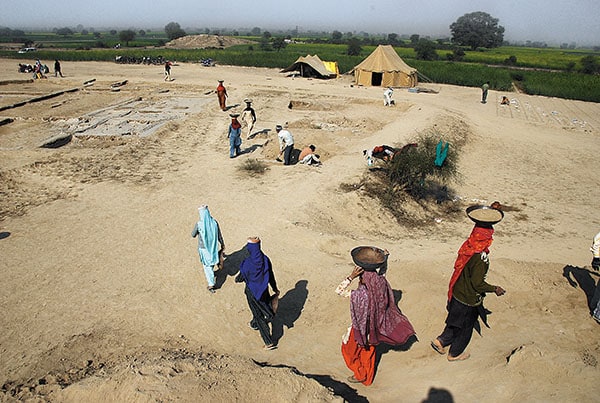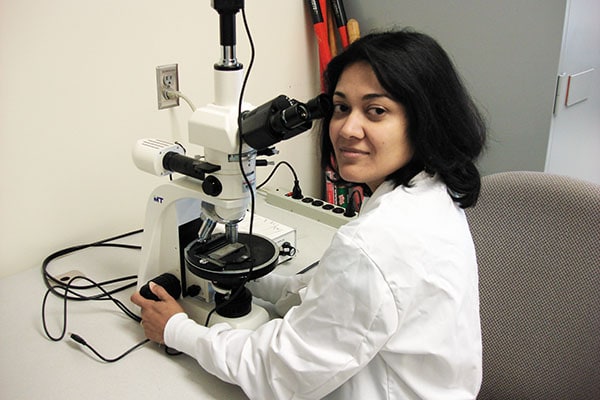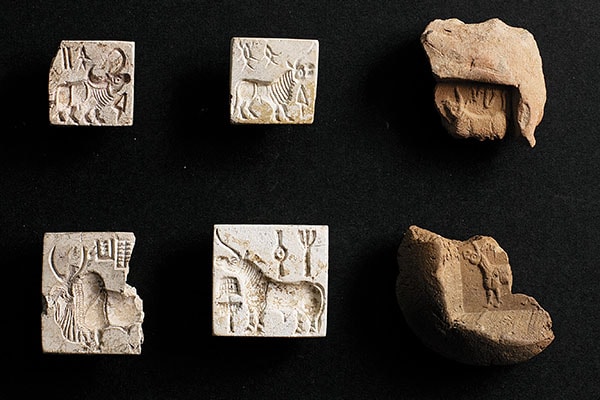What Did Our Ancestors Eat? Digging For Clues
What was on the menu at Indus Valley? The fascinating story of how archaeologist Arunima Kashyap decoded India's first foods


One day in 2010, Arunima Kashyap discovered a garlic clove. A 4,400-year-old garlic clove.
Kashyap, then 34, and her colleagues had been digging for two months by then. Sometimes, they were 100 of them in the pits, sometimes about 30. Sometimes, the pits were so deep they needed ladders. Sometimes, there were four people working shoulder to shoulder in a two-feet-by-two-feet space. One night, past midnight, they thought rain was imminent. Terrified that their precious remains would be washed away, they raced out and began covering up the dig with tarpaulin. When they finished, it was 4 am and it hadn’t rained. But it was almost time to start the day’s work.
On some days, it took muscle power and the indiscriminating scrape of a pick others demanded the delicacy of a miniaturist’s brush. All of it towards the possible glorious discovery of a garlic clove. A garlic clove a man or a woman had tossed into a cooking pot four millennia ago.
While the garlic clove excited Kashyap, her key discoveries didn’t happen Indiana Jones-style, in a flash of serendipity, at the Harappan site in Farmana, Haryana. They happened later in a lab, far away at the University of Washington, Vancouver.
The Menu
From astrophysicists to professors of computer science, linguists to mathematicians, scholars have been trying to crack the mysterious Harappan script for decades. Occasionally, they have flung their hands up in the air and sulked, saying that the Harappans were illiterate. Eventually, they have returned to the task with fervour. At every point, there has been reasonable interest in these proceedings and, to some extent, controversy (Harappans were proto-Dravidian? Scandal!).
There has been less interest in the archaeology of food. The international press did have a flurry of pieces about Kashyap’s findings early in 2013, mostly in a lighter vein, celebrating the oldest ‘curry’ in the world.
Traditional archaeology relies on the discovery of plant remains, seed grains and the odd, brave garlic clove that survives thousands of years. Macrobotanical findings—pollen grain and opal phytoliths—tell us that the Indus Valley civilisation produced wheat, barley, rice, sesame and mustard. Until recently, we knew little more. Is it really possible that one of the world’s great urban civilisations—we know it possessed advanced metallurgy, grid-like city planning and its own system of weight measurements—had a limited menu?
In India, as in many parts of the world, the serious study of food history is only coming into its own in recent years.
Pushpesh Pant, a professor of diplomatic studies at Jawaharlal Nehru University and author of many books on food, is deeply interested in how the same recipe mutates across eras. Salma Husain is a Persian scholar and authority on Mughal recipes.
Chennai-based chef Jacob Aruni, until his untimely death at 37 a few months ago, was establishing a name for himself as a generous, original and enthusiastic food historian. The most robust scholar of them all, KT Achaya, died in 2002, long before Instagram was taken over by ‘foodies’, but not before completing a slew of ambitious works, including The Story of Our Food and Indian Food: A Historical Companion.
Reading Achaya is a steady reminder of what Tom Standage, author of An Edible History of Humanity, believes: “Food’s influence on history can be likened to an invisible fork that has, at several crucial points in history, prodded humanity and altered its destiny, even though people were generally unaware of its influence at the time.”
Reading Achaya is also a reminder of the limitations faced by scientists trying to understand civilisation through food, the most perishable of evidence. The quixotic nature of this enterprise comes through in Achaya’s prim, precise prose about Harappan findings when he quotes an archaeologist talking of “a few seeds of the melon species which unfortunately were too brittle to be lifted up”. Archaeology seems to involve some squinting and a lot of imagining. “Fruits to be had had to be inferred from representations,” he writes decorative work on vases led archaeologists to guess the presence of lemon, pomegranate, coconut. “There is some reason to believe that bananas were also known,” Achaya adds tersely.
But now Kashyap had improved and perfected a technique that had been used to great effect by archaeologists outside India. On the basis of her findings, she expected to finally answer two questions: What did the Indus Valley civilisation grow? What did they eat?
The Ingredients
Malcolm Gladwell, who loves taking apart the idea of genius, would have a good time with the story of Kashyap’s entry into archaeology. She was a student of history at Presidency College, Kolkata, when her parents took her on holiday in Rajasthan in 1995. They stepped off a bus to buy water and overheard talk about an archaeological dig in the vicinity. Incredibly, Kashyap’s parents interrupted their travel plans to visit the dig at Balathal. Then, the man in charge, Professor Vasant Shinde of Deccan College, Pune, agreed to let Kashyap help at the site. Here came the second miracle: The senior Kashyaps agreed to continue their trip to Udaipur and let their excited 19-year-old daughter work at Balathal for two days. Those two days were to change Kashyap’s life forever: She would go on to apply for a master’s degree in ancient archaeology in Pune.
Balathal, 42 km from Udaipur, is a significant site of the Chalcolithic period and the Early Historic period. Between 1993 and 2000, a series of excavations yielded massive data indicating that Balathal was home to the Ahars, the earliest farmers in the region, and the centre of a civilisation that developed independent of the Harappans’. Kashyap spent two years trying to understand how the Ahars were influenced by the Harappans, their trading partners to the north.
For her PhD at Michigan University, Kashyap returned to Rajasthan, this time to Bagor in Bhilwara district, to figure out when and how the people of the region shifted from hunting-gathering to food production by examining stone tools. While working at the Smithsonian in 2005 as a pre-doctoral fellow, she discovered the exciting possibilities of the technique of starch grain analysis. 
Plants store starch granules for their own needs within seeds, fruits, roots and tubers. This starch is designed to survive extremes of weather. The granules survive long after the plant has died, retaining very distinct shapes and sizes, and allowing scientists to identify the specific species under a microscope. In the 1980s and 1990s, archaeologists became interested in starch grains. In 2006, archeobotanist Linda Perry used this technique to examine stone tools and pushed back corn cultivation in Peru by 1,000 years. A year later, she was able to demonstrate that 6,100 years ago, the pre-Columbian civilisation in Mexico grew seven different kinds of chilli and, further, used them both dry and fresh in their cooking.
A few years later, the Smithsonian was home to a major breakthrough in use of starch grain analysis. In 2011, Smithsonian archaeobiologist Dolores Piperno and her colleagues Amanda Henry and Alison Brooks showed, for the first time, proof that Neanderthals ate plants. Until then, it was widely believed that Neanderthals had died because of an all-meat diet—an assumption based on the fact that there were few plant survivors from that period. (An assumption that sounds not very different from the Harrapans-were-illiterate sulk, but can you blame them?)
To investigate the Neanderthal diet, Piperno and her colleagues examined the fossilised tartar on the teeth of Neanderthals from Iraq and Belgium—untapped research material—and found evidence of wheat, barley, legumes and date palms.
The desire to make jokes about brushing and flossing may be almost painful at this point, but hold on. Henry then made another astonishing discovery: Some of the starch grains had distortions that could not be explained by chewing. Henry attempted reverse engineering with fresh grains. She boiled some, baked some, roasted some. Comparing these starch grains, she concluded that the Neanderthals had not only eaten plants, they had even cooked them. Not making any more jokes, are we?
It is this marvellous possibility of discovering time capsules about entire civilisations in single molecules that keeps some archaeologists digging for grains. As anthropologist Kathleen Morrison, who has spent years working on the Vijayanagara period (13th-16th century) in Karnataka and is now looking at even older sites (3,000-1,200 BCE), says “When we only learn history in terms of kings and empires, it is easy to lose sight of the every day lives of people, and to imagine history as something really remote. But when we touch something made by another individual hundreds or thousands of years ago—I love it when we find finger or palm prints on pottery—we feel a connection and develop a sense of ourselves in both place and time.
Even if we don’t directly touch something, knowing small details of life in the past, like a way of cooking or eating, relates to something we all do now. We all eat.”
Just as importantly, Morrison points out, archaeologists are interested in how little and how much people ate. Archaeology can say things about people not represented in texts, including the women, the children, the poor and the dispossessed. “It is clear [from our work] that by the Vijayanagara period, there was a sharp distinction between foods of the poor and elite foods the latter required a lot of investment in this dry region, investment in irrigation features, labour and land. It is exciting to work out the forms of agriculture that were practised in different parts of the region as the city of Vijayanagara grew, and then was abandoned,” she says.
The Method
When Kashyap began work at Farmana in January 2010, she combined several existing techniques to extract starch granules from 50 different surfaces, including vessels, stone tools and the teeth of skeletal remains from burial sites. Working with her mentor Professor Shinde, she began with the earthenware vessels. “In India, residue analysis was unheard of. You just wash it off and it becomes…pottery,” Kashyap laughs.
Since Kashyap had been trained in the US, where archaeology is a part of the anthropology department (and not history), she was also trained in ethnographic studies, which translated into spending a lot of time in contemporary Farmana homes, watching people cook, observing the recipes, the wood, the ingredients. This exposure would come in handy when she was ready to begin her own reverse engineering exercises.
Eventually, it was time to pack up and return to the lab. Kashyap began by using time-tested techniques but she also had to develop some important hacks of her own. Stumped by the identity of particular starch grain molecules, for instance, she made two significant innovations. First, instead of using test tubes, she cooked grains and vegetables in ceramic to best replicate Harappan cooking conditions. Next, she started adding spices and aromatics to the vegetables. “Nobody cooks vegetables without spices, I thought.”
She also made a small detour. At a conference in Europe, a casual conversation reminded her that even today in Farmana cattle are fed household leftovers. What if the Harappans had done the same? From a colleague, she got hold of well-preserved cattle remains from the era and scraped their teeth. Her hunch had been right: She retrieved more starch grains that she could take a look at.
Months of work later, to her delight, one of the starches to show up was from her favourite vegetable, the brinjal. And slowly a picture emerged: Brinjal cooked with ginger and turmeric. The earliest known use of ginger and turmeric.
Then she found evidence of little millet and foxtail millet, too small and too easily carbonised to have been identified in traditional archaeological work. Then, gram and horsegram. Mango.
And later, confirming Achaya’s terse prophecy: Bananas.
Three years after her stunning discoveries, the archaeologist is on a sabbatical from the field right now. It is more than a little entertaining to learn that Kashyap, a bulk of whose archaeological life was spent examining stone tools, has a parallel life studying methods to improve the ways humans use technology at Intel in Hillsboro, Oregon.
Her important breakthroughs in understanding the Harappan civilisation have gone largely unnoticed in India and, as Kashyap says without rancour, occasionally wrongly credited in the international science press.
Looking back at the months in the pits, Kashyap says the best day was when “a gang of Haryanvi schoolgirls arrived accompanied by their teacher in a little bus.” They were tickled to confirm what they had read—but not believed—in the local papers: A woman archaeologist neck-deep in a hole in the ground.
It’s not irrelevant that in Kashyap’s specialty area of archaeology—plant remains—women are the majority today, though not in India. As Morrison says, “Across the world, archaeological interest in food and cooking has been growing, and many people feel that the increased representation of women in the field is a major reason for this. Topics like food processing and cooking never got much attention in the past because they were seen as ‘women’s work’ and hence unimportant. I’d note that in India there is a critical shortage of archaeologists trained to do most kinds of specialised analysis, including the study of plant and animal remains, not to mention ancient diet from human skeletal analysis. So, we are not really struggling with gender bias so much as with more basic problems of getting archaeological data properly analysed and available.”
Kashyap, who talked up a storm to the schoolgirls that day, fervently hopes that one among them will be bitten by the bug, just as she was. And we will learn more about what their ancestors ate.
First Published: Apr 11, 2014, 06:57
Subscribe Now